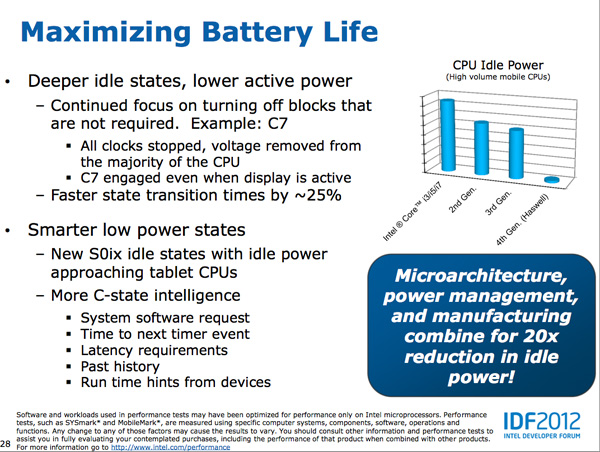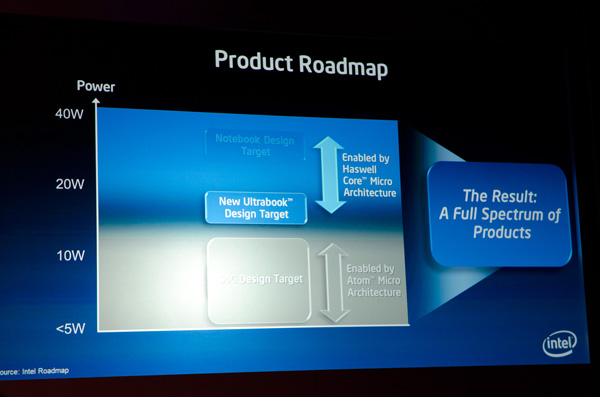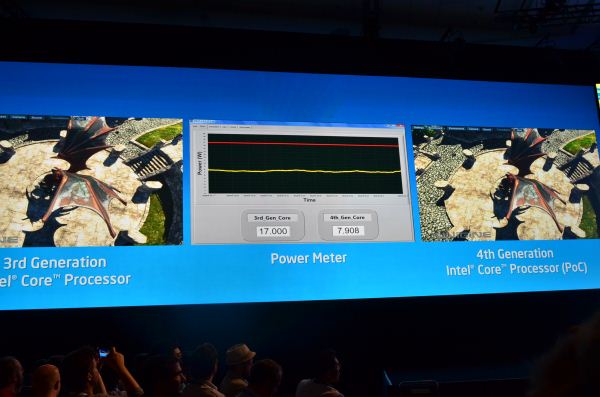Intel's Haswell Architecture Analyzed: Building a New PC and a New Intel
by Anand Lal Shimpi on October 5, 2012 2:45 AM ESTOther Power Savings
Haswell's power savings come from three sources, all of which are equally important. We already went over the most unique: Intel's focus on reducing total platform power consumption by paying attention to everything else on the motherboard (third party controllers, voltage regulation, etc...). The other two sources of power savings are more traditional, but still very significant.

At the micro-architecture level Intel added more power gating and low power modes to Haswell. The additional power gating gives the power control unit (PCU) more fine grained control over shutting off parts of the core that aren't used. Intel published a relatively meaningless graph showing idle power for standard voltage mobile Haswell compared to the previous three generations of Core processors.
Haswell can also transition between power states approximately 25% faster than Ivy Bridge, which lets the PCU be a bit more aggressive in which power state it selects since the penalty of coming out of it is appreciably lower. It's important to put the timing of all of this in perspective. Putting the CPU cores to sleep and removing voltage/power from them even for a matter of milliseconds adds up to the sort of savings necessary to really enable the sort of always-on, always-connected behavior Haswell based systems are expected to deliver.
Intel has also done a lot of work at the process level to bring Haswell's power consumption down. As a tock, Haswell is the second micro-architecture to use Intel's new 22nm tri-gate transistors. The learnings from Ivy Bridge are thus all poured into Haswell. Intel wasn't too specific on what it did on the manufacturing side to help drive power down in Haswell other than to say that a non-insignificant amount of work came from the fabs.
The Fourth Haswell
At Computex Intel's Mooly Eden showed off this slide that positioned Haswell as a 15-20W part, while Atom based SoCs would scale up to 10W and perhaps beyond:
Just before this year's IDF Intel claimed that Haswell ULT would start at 10W, down from 17W in Sandy/Ivy Bridge. Finally, at IDF Intel showed a demo of Haswell running the Unigen Heaven benchmark at under 8W:
The chain of events tells us two things: 1) Intel likes to play its cards close to its chest, and 2) the sub-10W space won't be serviced by Atom exclusively.
Intel said Haswell can scale below 10W, but it didn't provide a lower bound. It's too much to assume Haswell would go into a phone, but once you get to the 8W point and look south you open yourself up to fitting into things the size of a third generation iPad. Move to 14nm, 10nm and beyond then it becomes more feasible that you could fit this class of architecture into something even more portable.
Intel is being very tight lipped about the fourth client Haswell (remember the first three were desktop, mobile and ultra-low-volt/Ultrabook) but it's clear that it has real aspirations to use it in a space traditionally reserved for ARM or Atom SoCs.
One of the first things I ever heard about Haswell was that it was Intel's solution to the ARM problem. I don't believe a 10W notebook is going to do anything to the ARM problem, but a sub-8W Haswell in an iPad 3 form factor could be very compelling. Haswell won't be fanless, but Broadwell (14nm) could be. And that could be a real solution to the ARM problem, at least outside of a phone.
As I said before, I don't see Haswell making it into a phone but that's not to say a future derivative on a lower power process wouldn't.













245 Comments
View All Comments
Magik_Breezy - Sunday, October 14, 2012 - link
Anything delivers "solid performance" on Facebook & iWorkWhy pay $2,000 for that?
random2 - Friday, October 5, 2012 - link
I agree. admittedly I am not an apple fan and view them as people who have undergone a degree of brainwashing compounded by the need for some to keep up with the Jone's. A certain degree of mind control must be necessary to stick with a company that has had some questionable business practices as far as customer relations, dealing with product issues and denying said issues, not to mention the whole hypocritical stance by apple in regards to copyright infringement has also left a bad taste in my mouth.hasseb64 - Saturday, October 6, 2012 - link
Disagree, not that much new from already published IDF reports almost 1 month ago. What is intresting is the claimed 40 EU GT3, other sources say lower amounts.JKflipflop98 - Saturday, October 6, 2012 - link
I totally agree. It's articles like this that have kept me coming back for years. Keep up the good work Anand!tipoo - Sunday, October 7, 2012 - link
"You can expect CPU performance to increase by around 5 - 15% at the same clock speed as Ivy Bridge. "That seems terribly disappointing for a tock, even IVB as a Tick managed 10% in most cases.
medi01 - Tuesday, October 9, 2012 - link
One can't be biased !@# !@#@ and a good journalist at the same time.One needs to be blind not to see how glass is always half empty for AMD, and half full for nVidia/Intel. F**!@#'s were shameless enough, to test 45W APU with 1000W PSU and such crap is all over the place.
Paulman - Friday, October 5, 2012 - link
As I was reading this article, about part way into the low platform power sections I suddenly had this thought: "Oh man, AMD is gonna die...!"I don't know if that's true for the entire microprocessor side of AMD, since they look like they're already starting to transition out of the desktop space, but I don't know if they're going to stand much of a chance if they're planning on entering the same TDP range as Haswell.
Do you think there's a chance AMD will start focussing on designing ARM ISA cores? Or will expanding on their x86 Bobcat-type cores be enough for them?
sean.crees - Friday, October 5, 2012 - link
I also worry about AMD. AMD has been 1-2 steps behind Intel for a while now, and now it seems Intel is at least 1 or 2 steps behind ARM and the future. Is that going to mean AMD is just too far behind to stay relevant now? If nothing else, i suppose AMD can fall back on graphic cards with it's ATI acquisition.Da W - Friday, October 5, 2012 - link
If Haswell keeps x86 relevant in the tablet space and thus Windows 8 has the upper edge over Windows RT and Windows tablets can grab +-50% market share from the iPad, then it can be good for AMD, provided they survive that long.RedemptionAD - Friday, October 5, 2012 - link
If AMD can create a team to focus on increasing IPC with a goal to one up Intel and have the ATI graphics people keep doing what they do with a time goal of say 2 years, (Note: Portables/Notebooks/Desktops should all be x64 by then), then I think that AMD will be able to return to their Athlon 64 glory days or better.